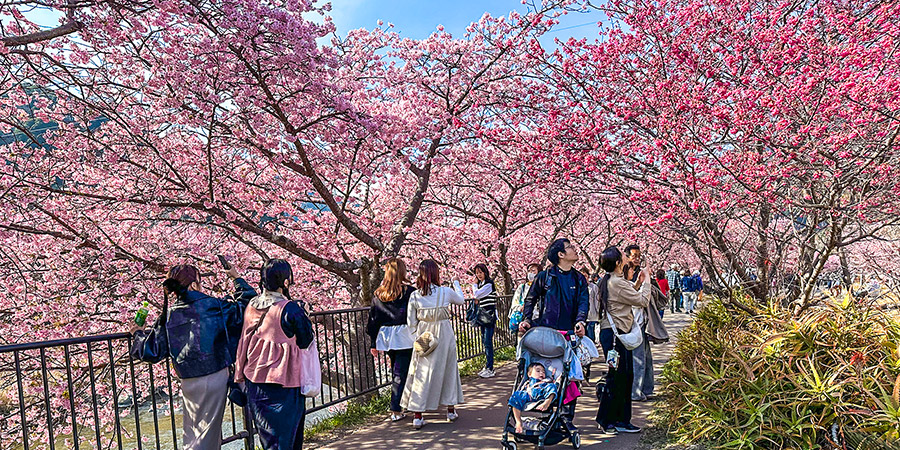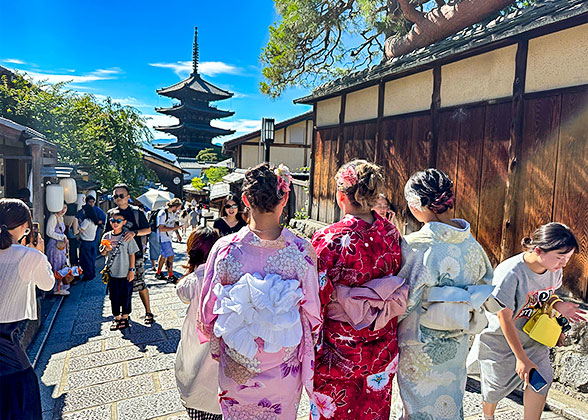Maruyama Park (Kyoto)
Maruyama Park, established in 1871 and officially opened in 1886 during the Meji era, is the oldest park in Kyoto. But its age is not as famous as hundreds of cherry trees it boasts, of which “Weeping Cherry of Gion” is the most spectacular and known across the whole nation. As such, it is the best place to experience the Hanami Festival, during which people would form picnicking parties under pink clouds of cherry blossoms. The park lies to the east of Yasaka Shrine and Gion area in the Higashiyama District, landmarks to be included in every travel itinerary of Kyoto.

Maruyama Park
|
Kyoto’s Most Popular Spot to View Cherry Blossoms
Maruyama Park is particularly loved by locals and travelers alike for its some 680 cherry trees, which explode with cherry blossoms from late March to early April. Two sights need special attention: Weeping Cherry of Gion and Yozakura, night viewing of illuminated cherry blossoms.Weeping Cherry of Gion, the Queen of Cherry Trees
Standing at the very center of the park is Weeping Cherry of Gion, or Gion Shidare-zakura in Japanese, whose fame has spread across Japan, especially when it’s illuminated at night. It was actually grown out of a seed of an ancient cherry tree, which dated back to the Edo-period (1603 - 1868) and died after the seed was planted in 1928. Just as the name suggests, the tree has cascading branches that droop toward the ground – a species elegant and rare.Yozakura: View Lit Pink Cherry Blossoms against the Dark
The night viewing of Yozakura is a tradition practiced annually in the cherry blossom season. Together with the Hanatoro Festival, during which the Higashiyama District – and thus including Maruyama Park - is illuminated with thousands of lanterns at night in each March, the scene of Yozakura will surely take its beholders to a magical dimension.

Maruyama Park in Autumn
|
Eat Under Pink Clouds
Unlike other places of Kyoto for cherry blossom viewing, visitors here can eat under cherry trees to celebrate Hanami Festival, or the Cherry Blossom Festival, whether it’s self-prepared picnicking or eating at temporary dining tables set by food stalls in the park. Life here is even vibrant and lovely at night during this time, as locals would gather here to effusively chat over beer or sake.Know Before Going
Opening hours: Open all year roundAdmission fee: free
Best time to visit: During late March and early April
How to Get There (from Kyoto Station)?
By bus:Take bus No. 46/203/206/207 to Gion Stop and walk less than 5 minutes.
By train:
Take the JR Nara Line to Tofukuji Station, change to the Keihan Line to Gion-Shijo Station, and walk about 10 minutes.
Nearby Attractions
![]() Yasaka Shrine (Connecting the west of Maruyama Park)
Yasaka Shrine (Connecting the west of Maruyama Park)
Yasaka Shrine, aka Gion Shrine, is the head shrine of over 3,000 Yasaka Shrines of Japan. It’s where the most celebrated Gion Festival originated, which lasts a whole month of July to purify Kyoto of negative spiritual energy.
![]() Gion (A few minutes’ walk west)
Gion (A few minutes’ walk west)
Gion is the most historic area of Kyoto in the front of Yasaka Shrine to experience a timeless Edo-era vibe, with old tea houses and mysterious geishas to pass by.
|
|
|
Kiyomizu-dera is an UNESCO-preserved temple dating far back to 778 AD. Its main hall was built without a single nail, and is thus a man-made miracle to behold. People are flocking here to stand on its veranda to have a panoramic view of the surroundings, Kyoto streets included.
As the most ancient Zen Temple in Kyoto and even Japan, Kennin-ji is where to find beauty and peace amid the busy area of Gion.





